Rich Thom / Photos by Rich (unless noted)
Clinic Chair Rich Blake welcomed 25 folks to the Skagit Valley & Whidbey Island Clinic’s October meeting at the Summer Hill facility in Oak Harbor, especially welcoming new guests Glen Sherwood, Doug Seward, and James Golder. Jim has acquired two second-hand HO layouts and is busy planning how to combine them in the available space offered by a three-car garage. Rich reviewed the calendar of upcoming events, highlighting the 42nd annual Pacific Science Center Model Railroad Show, 16-18 January 2016. SV & W clinic members have supported this popular show for years and continued volunteering was encouraged. Susan Gonzales, our energetic program chair, first mentioned the Oct. 24th self-drive visit to the Northwest Railway Museum, Snoqualmie for a personalized tour of the Conservation & Restoration Center and other facilities, and train ride. (As this is written, a successful outing completed.) Susan then reviewed the season’s line-up of clinics. On November 11th a brand new program by Bob Stafford, retired BNSF trainmaster, will describe prototype operations in Bellingham, Everett’s Delta Yard, and other places. In December, Dick Haines tackles a weighty question which many of us of a certain age ponder: “just what exactly will become of my treasures when I no longer need them?” In January, a “make and take” is on the program (item to be “made and taken” still undecided).
In February the popular annual contest (this will be our clinic’s fourth) takes place with judging of this season’s Flatcar and Load Contest. Contest shepherd Jack Tingstad, encouraging everyone to start now and not in January, outlined the categories for this year’s competition (entries can be in any scale):
- Scratch-built flatcar with a scratch-built load
- Commercial flatcar with a scratch-built load
- Car and load both commercial but both super-detailed
- Novelty category
Dick Haines led off the mini-clinics with a slick Powerpoint presentation which asked: “why not put some of your detailed modeling below ground?” Dick had a modest trackside area available, and decided to install a course of piping, sewer and water and other utilities — below grade. The result (see Figure 1): a detailed HO-scale “structure” that attracts attention! Novel idea!
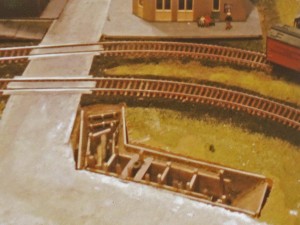
Fig 1 – Dick Haines’ HO-Scale Underground Water and Sewer Line Model Installed on his Layout Photo: D. Haines
Susan Gonzales followed with a quick tip from absentee Phil Gonzales (away on a fishing trip to eastern Washington – has Phil prioritized his hobbies correctly? that is a tough call!) about an easy way to paint storage tanks. Use hammered paint, from Walmart or Home Depot or your favorite outlet — works great.
John White was next up, praising the virtues of Gatorfoam Heavy-Duty Foam Board (www.graphicdisplayusa.com) for building construction. John’s extensive On30 layout features several detailed, scratch-built structures, many built with Gatorfoam walls and roofs. Gatorfoam stays flat and does not warp with humidity or paint like common foamcore. Cutting is easy (don’t use a no. 11 blade, John emphasizes!) with an ordinary utility knife. John brought in two samples: the bare walls of the under-construction Haines Meat Packing Plant (Figure 2), and a completed structure (Figure 3). The edges of the Haines building sides are notched to make construction easy and keep walls true: just a rubber band keeps the whole thing together when gluing. You won’t find Gatorfoam in your local craft store, but it’s available from suppliers such as Dick Blick (www.dickblick.com) and Micromark (www.micromark.com).
Alan Murray brought for discussion two O-scale kits (Fig 4) he has nearly completed: a Sidetrack Laser (www.sidetracklaser.com) warehouse (in back) and a shack with woodpile (front) from Morgan Hill Models (www.morganhillmodels.com). Alan has added details to both including interior paneling. Fine work!
Jack Tingstad is working towards his “Cars” AP in the NMRA certificate program, and brought in several models (and experiences) to help others capture this award if they are keen on pursuing it. A lot depends on applied detail, especially underbody detail, and Jack illustrated the point with an Ambroid “box of sticks” he is completing, adding all brake rigging to the car from prototype drawings available on-line. Another hint: research the details of the specific car you are building and document all of it to submit with your model.
Rich Blake wrapped up the evening with a demonstration of how to put to model-railroad use products made for other modelers — in this case, military modelers. A continuing theme by Rich, thousands of supplies are produced for modelers of military, automotive, and aviation prototypes and many of them are entirely suitable for model railroad use. The label doesn’t have to read “Floquil” to be useful! Tonight Rich highlighted products made by AK Interactive (www.ak-interactive.com), both oil paints and pigments.
Rich showed that oil paints (yes, oil paints, like the artists use) can be ideal for weathering. Oils can be used as a wash, and Rich demonstrated how to easily apply them using an N-scale car donated by Al Frasch:
- Apply dabs of oil colors desired on a 3 x 5 card; let sit for at least 30 minutes to let excess linseed oil soak into card
- Liberally coat the surface to be weathered with turpentine
- Using a small pointed brush or a microbrush, apply a few small spots of oil paint onto the turpentine covered surface
- Wipe the spots (downward, usually, or otherwise in the natural weathering direction) with a second broad brush wetted with turpentine, to flow the color
Rich passed around the paints he used: MIG Productions Oilset for Modelers. In the short time he had for the demonstration, the weathering result was excellent.
Pigments are another product to use, marketed by the same company. They don’t have an amalgamate, and need to be applied over a dull-coat layer, as well as followed after application with one or more dull-coat applications to seal the pigment in place. Rich extolled an alternative to Testor’s Dullcote, namely Future Acrylic Floor wax. This product can be diluted with Tamiya Flat Base (X-21) to produce anywhere from a very flat dull finish to satin. Airbrush cleanup is easy with 90-percent iso alcohol.
Rich had three O-scale models to show off (Fig 7), all weathered with the methods he demonstrated this evening. From front to back in the photo: a donkey, a Wiseman Model Services single-spool Dolbeer donkey engine kit (www.wisemanmodelservices.com), a Davenport “critter”, and a water car.

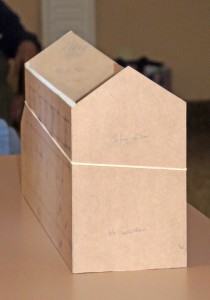
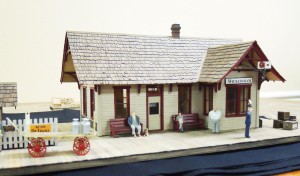
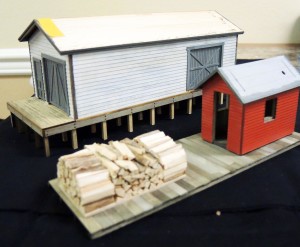
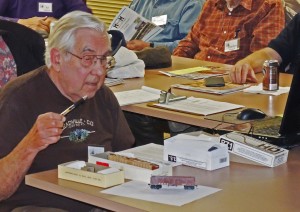
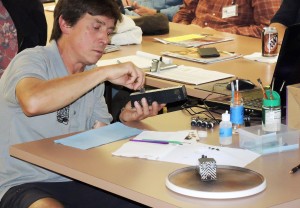
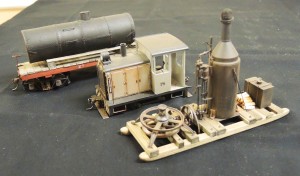
Great report on your activities up there. We will feature some “hands on” clinics in the spring at our annual meeting, probably in Snohomish County.
Russ Segner